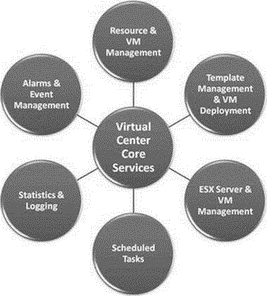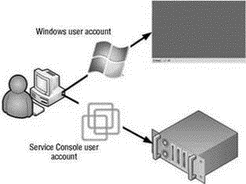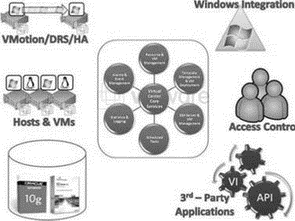Книга: Mastering VMware® Infrastructure3
Introducing VirtualCenter 2.5
Разделы на этой странице:
Introducing VirtualCenter 2.5
As the size of a virtual infrastructure grows, the ability to manage the infrastructure from a central location becomes significantly more important. VirtualCenter 2.5 is a Windows-based application that serves as a centralized ESX Server and virtual machine management tool. VirtualCenter acts as a proxy that performs tasks on the individual ESX Server hosts that have been added as members of a VirtualCenter installation. VirtualCenter is licensed and sold as an optional component in the VI3 product suite. VirtualCenter offers terrific enhancements in the areas of:
? Resource management for ESX Server and virtual machines
? Template management and virtual machine deployment
? ESX Server and virtual machine management
? Scheduled tasks
? Statistics and logging
? Alarms and event management
Figure 5.1 outlines the cores services available through a VirtualCenter installation.

Figure 5.1 VirtualCenter 2.0 is a Windows-based application that allows virtual infrastructure administrators to centrally manage ESX Server hosts and their respective virtual machines.
In a virtual infrastructure with only one or two servers, administrative effort is not a major concern. Administration of one or two servers would not incur incredible effort on the part of the administrator, and the creation of user accounts for virtual infrastructure administrators would not be too much of a burden. In situations like this, VirtualCenter may not be missed from a management perspective, but it will certainly be missed from a feature set viewpoint. In addition to its management capabilities, VirtualCenter offers the ability to perform VMware VMotion, configure VMware Distributed Resource Scheduler (DRS), and establish VMware High Availability (HA). These features are not accessible when ESX Servers act as individual servers running under a host-based license. VirtualCenter should be considered a requirement for any enterprise-level virtualization projects.
VirtualCenter Requirement
VirtualCenter is not a requirement for a virtualized server environment. However, to utilize the advanced features of ESX Server (such as Update Manager, VMotion, DRS, and HA), VirtualCenter must be licensed, installed, and configured accordingly.
As a byproduct of an ever-growing virtual infrastructure, new users will consistently be brought into the environment. These users will likely need various levels of permissions to perform their job. VirtualCenter includes a scalable framework for providing Windows users and groups with varying levels of access to objects throughout the inventory.
VirtualCenter, acting as proxy for host and virtual machine management, does not store the virtual infrastructure data locally on the VirtualCenter server. Instead, all data is stored on a back-end database server that runs either Microsoft SQL Server or Oracle. In the section ‘‘Installing the VirtualCenter Back-end Database’’ later in this chapter, we will dig deeper into VirtualCenter planning. We will discuss the importance of data availability from the database server perspective.
In Chapter 2, we discussed a user's authentication to an ESX Server under the context of a user account created and stored in the Service Console. Without VirtualCenter, a user account on each ESX Server would be required for each administrator who needed access to the server.
VirtualCenter installs on a Windows Server operating system, and uses Windows' user accounts and groups to authenticate to VirtualCenter. These users and groups can reside in the local security accounts manager (SAM) of VirtualCenter, or they can belong to the Windows Active Directory domain to which VirtualCenter server belongs. For example, if a user account named Shane is created in the Service Console of an ESX Server host named silo3504.vdc.local and the user account is granted the permissions necessary to manage the host, Shane will not be able to utilize the Virtual Infrastructure Client connected to VirtualCenter to perform his management capabilities. The inverse is also true. If a Windows user account named Elaine is granted permissions through VirtualCenter to manage an ESX Server host named silo3505.vdc.local, then Elaine will not be able to manage the host by using the Virtual Infrastructure Client to connect directly to the ESX Server. Figure 5.2 exemplifies the authentication agents when using the Virtual Infrastructure client to connect to an ESX Server host or a VirtualCenter Server.

Figure 5.2 The Virtual Infrastructure client can be used to connect directly to an ESX Server under the context of a Service Console (Linux) user, or it can be used to connect to a VirtualCenter under the context of a Windows user.
Virtual Infrastructure Client
Logging on to an ESX Server host using the Virtual Infrastructure (VI) Client requires the use of an account created and stored in the Service Console. Using the same VI Client to connect to a Virtual-Center requires the use of a Windows user account. Keep in mind that VirtualCenter and an ESX Server host do not make any attempt to reconcile the user account for each respective accounts database.
Using the Virtual Infrastructure Client to connect directly to an ESX Server that is currently being managed by a VirtualCenter server can cause negative effects in VirtualCenter. Successful logon to a managed host will result in a pop-up box warning you of this potential problem.
The VirtualCenter component of VI3 is the most extensible in regard to allowing third-party support. Some of these applications will be covered in Appendix A. Figure 5.3 shows the many components that revolve around the core services of VirtualCenter 2.5.

Figure 5.3 Although the foundation of virtual infrastructure is the ESX Server product, it is VirtualCenter that provides enhanced functionality and added features like HA, DRS, and VMotion as well as centralized management.
A key aspect for the success of virtualization is the ability to allow third-party companies to provide additional products that add value, ease, and functionality to existing products. VMware has shown its interest in allowing third-party software development houses to play an integral part in virtualization by providing an application programming interface (API) to VirtualCenter. This API allows companies to develop custom applications that can take advantage of the virtual infrastructure created in VirtualCenter. For example, Vizioncore's vRanger Pro, a product we will look at in our appendix of tools, is a simplified backup utility that works off the exact inventory created inside VirtualCenter to allow for advanced backup options of virtual machines.
This chapter will cover the installation, configuration, and management of VirtualCenter. In addition, you will find helpful information about best practices for VirtualCenter maintenance, availability, and disaster recovery. A detailed look at templates will be provided in Chapter 6, and Chapter 11 will offer an in-depth look at ESX Server and virtual machine monitoring.
- Introducing VirtualCenter 2.5
- Installing the VirtualCenter Back-end Database
- ESX 3.5 and VirtualCenter 2.5 Licensing Strategies
- Installing VirtualCenter 2.5
- Creating and Managing a VirtualCenter Inventory
- Using VirtualCenter Topology Maps
- Planning a VirtualCenter Deployment
- Managing VirtualCenter Settings
- The Bottom Line
- Chapter 5 Installing and Configuring VirtualCenter 2.0
- Introducing Postfix
- Chapter 1: Introducing VMware Infrastructure 3
- Chapter 1 Introducing VMware Infrastructure 3
- CHAPTER 1 Introducing Eclipse
- Creating and Managing a VirtualCenter Inventory
- Using VirtualCenter Topology Maps
- VirtualCenter Best Practices
- Installing the VirtualCenter Back-end Database
- ESX 3.5 and VirtualCenter 2.5 Licensing Strategies
- Chapter 5: Installing and Configuring VirtualCenter 2.0
- Installing VirtualCenter 2.5




